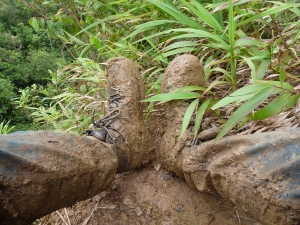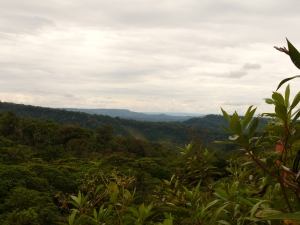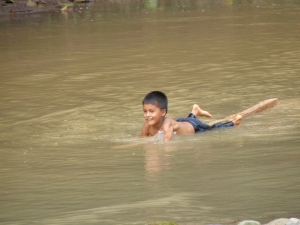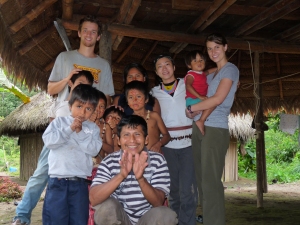Our current home city, Puyo, is essentially the last bastion of organized civilization in eastern Ecuador before the Amazon starts in earnest. Last Tuesday, we took a bumpy, hour-long car ride further east to a well-worn trailhead that provides access to the shadowy depths of the jungle. There we met our guide/host, Gustavo Moncayo, a middle-aged, nimble little man whose eyes seem to perpetually shine—a smile never far from the corners of his lips. Gustavo is a member of the Shuar community, the still-prevalent Amazonian jungle tribe, and he lives with his family in a tiny 20 person village in the rainforest. He sat waiting on the edge of the road with two of his ten children—15-year-old Milka, and 10-year-old Danilo. Gustavo is happy monogamously married, but it is still commonplace for Shuar men to have multiple wives. Gustavo greeted us with a calloused handshake, swung his machete over his shoulder, pointed out over a thickly jungled mountain, and simply (though cheerily) said, “Home’s this way!”
With that he promptly turned around and started walking the other way. We exchanged confused looks and started after him before his kids stepped in and informed us that he was off to buy supplies for another son (who is attending high school in Puyo) and that he would catch up. And so we set off, three Americans following the young, energetic Shuar kids out into the rainforest.
The trail we travelled is the only means of accessing three jungle villages that are scattered throughout that small western chunk of the Amazon. The villages typically consist of two or three families, range from 15-30 members, and are completely self-sufficient. We quickly discovered that the trail wasn’t much of a trail at all, but more of a 10-mile long river of mud and rock spilling down from an obnoxiously tall mountain. To call what we did “slogging” would be a dramatic understatement. For every step forward, you slid half a step back and sank 8-10 inches into the wet, sludgy clay. Any solid-seeming foothold usually turned out to have been a mirage, as rocks sank, logs broke, and termite-infested stumps crumbled away. With a 50 pound camping pack on your back, every slip and fall was drastically magnified, and before too long we were all slipping, sliding, and stumbling all over the path like so many drunkards.
By the time we took our first break 1.5 hours in, Gustavo had caught up with us and was miraculously mud-free. It was mind boggling, but we were really cowed when, as we sat there, an 8-year-old girl caught up to us… with her 3 year old sister in a sling on her back. As we sat there, sweating, panting, and cursing, she just kinda tilted her head to the side—as if deeply pondering what these giant white kids could possibly be doing sitting in the middle of her path. It turned out the sisters were the youngest two daughters of the only other family that makes up Gustavo’s village, so they followed us the rest of the way—all five hours—with a considerable amount more grace and dignity than us.
By the time we finally made it to the village, situated in the fork of a river deep in the jungle, we hardly had the energy to greet our new hosts. We stumbled into the river fully clothed, and lay down to try to recover.
The rest of Gustavo’s young boys, after managing to resist the urge to swarm us for a polite 3 minutes, stripped down and ran laughing after us. The six young boys—Danilo, Christian, Alex, Jose, Jackson, and 1-year-old Ricky (a grandson of Gustavo’s, not a son like the rest)—were ecstatic to have company, and they quickly set about impressing us by floating their boats (logs upon which they laid belly down) by us down the rocky river. They wrestled and splashed and laughed and generally just cheered us up with their exuberance.
****Side note—we figured they’d eventually run out of energy, but we were sorely mistaken. They were relentlessly, hilariously out of control for the duration of our four days there—demanding Caballo! (piggy back rides) and Avión! (airplane rides) literally non-stop for the entirety of our stay. It was only made worse by the fact that we brought them some candies and snacks… that could have been a mistake. It was an absolute madhouse. But in a good way.****
Eventually, after finally dragging ourselves out of the water, we returned to the house to move in and check the place out. Gustavo’s family’s compound consisted of 3 buildings—a sleeping cabin for the family, a sort of pavilion with a loft (where we slept), and a round kitchen hut. The pavilion was decorated with the skulls, skins, and hides of the various animals that had been unlucky enough to wander into the compound under Gustavo’s watchful eye. Two tiger pelts hung beside two anaconda skins which were hung beside various deer skulls and turtle shells. Not an unimpressive sight. While there was a generator that serviced a lone, bare lightbulb for emergencies, there was not a single other electric appliance to be found (which explained the kids’ fascination with everything from our watches to our cameras to our cell phones—pretty much anything that made light or beeped). They had running water out back behind the kitchen hut—a hose that simply ran down hill from a nearby river. Clothes lines ran back and forth between every building, but with the daily rains, most clothes just kinda hung until they were needed, at which point they were thrown on, damp or not. There was another family with a similar setup about 100 yards away. Gustavo’s oldest daughter married into that family a few years ago, and now lives over there—just out of sight. Between the two families was a tiny school building for children to attend until they reached the middle school level, at which point they move into Puyo alone to continue their education. A bumpy dirt soccer field with netless log goals lay just outside the school. Countless ducks and chickens wandered aimlessly among the buildings, searching for scraps, dodging kicks, and avoiding the three mangy (but still pretty darn cute) family dogs.

Home! Pavilion in the center (we slept upstairs) kitchen hut to the left, family sleeping quarters to the right.
That first day, we rinsed off in the river, unpacked our backpacks, and then went to the kitchen to eat dinner. The family has a sizeable field of corn, numerous plantain trees, and so just about every single meal consisted of the two, plus the occasional potato and maybe a small chunk of meet if some beast wandered too close. On our final morning, we were awakened by a gunshot at 3 in the morning and found capybara meat on our plates the next morning.
After dinner that first night, Gustavo’s children dressed up in traditional clothing and danced a “welcome dance” for us, botching most of the words and forgetting most of the steps, but it was still pretty cute. We even got to dance along a little bit. Then it was off to bed at about 8:30.
Over the next two days, we learned a ton about the Shuar lifestyle. That fist morning, Gustavo’s wife taught us how to strip leaves to twist into twine, cauterize the ends, and then thread dried seeds to make traditional jewelry. In the afternoon they taught us how to make homemade (and freaking delicious) tamales and salsa, then we played an epically muddy game of soccer before invading the river to splash around and clean off. That night we stayed up chatting about their different options of medical treatment should something happen out there in the middle of the jungle before cashing in just after dark. The next morning we rose again with the sun and hiked out to a waterfall that, according to Shuar lore, holds mystical powers. Along the way we stopped, examined, and tried out various herbal/natural remedies (the knowledge of which having been passed down from generation to generation by the Shuar people). When we finally made it to the waterfall, we were respectful of it’s legend for a few minutes… and then we all dove in the water to cool off and play. Gustavo mashed up the meat of a certain tree that, when mixed with water foams, acts as a pretty solid natural substitute for soap.
That afternoon we returned home and learned how to fish. Ever clever, Gustavo showed us how to knit a series of bamboo-like stalks together so that water could seep through, but not a whole lot more. We made it about 6 feet wide and then brought it down to the river where we used rocks to divert a small section into a sort of hand-made stream, and then laid our trap down so that the river flowed right into it, but the back of the stalks was elevated out of the water. This way, any fish that swam that way would be cleverly plucked right out of the water. We coated the sides and bottom of our canal with leaves, then covered the top of our trap so that no fish could flop out once caught. To really function, the trap would have had to be a few times as big as ours, but it was still a pretty ingenious method for fishing.
That final night we feasted again, and then sat out under what was our first clear jungle night. The stars were incredible, and we probably could have stayed up forever out under their light, but the fact that we were to rise and depart at 7, combined with some mysterious rustling in nearby bushes, convinced us that it was probably bedtime, so we retired for the final time in the jungle.
The next morning, we said our sad goodbyes to the kiddos, and promised we’d send them pictures with the next group of students. Then began our awful 5-hour hike back to the main road. Even after only a week living in the jungle, we were all weary down to the bone, and so it’s impossible not to have an immense amount of respect for these people who live this life every day. I am incredibly grateful to have had this experience, but despite what I might have previously thought—I’ve no delusions that I’d struggle mightily to keep up with the jungle lifestyle. But that said, this past week has definitely been the most incredible part of my journey this summer, and it alone was validates my coming for this trip. Again, I’m super grateful for having had this opportunity.



















Recent Comments